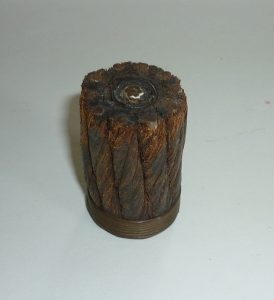Fragment of submarine cable, ca. 1869
gutta percha; copper wires; hemp fibers
Dimensions: 1 ¾” (h) x 1 ¾” dia.
Gift of Mrs. Dawn Wilde (2013.19.26)
Fragment of submarine cable
Fragment of submarine telegraph cable. 10 strands of copper wire and hemp fibers, wrapped around a center copper wire core. Metal band at one end, holding fragment together. Relatively small diameter for transatlantic cable.
In 1866, Great Britain and North America were connected via a transatlantic communications cable. The Great Eastern successfully laid a 2,000 mile-long cable across the ocean floor from Ireland, bringing it ashore in Newfoundland in 1866. It cost more than $1.5 million dollars, and took five attempts and more than 10 years to accomplish.
Once Great Britain and North America were connected, the French sought to have their own exclusive means of transatlantic communication. As with the Anglo line, the French Atlantic Telegraphic Company used the now tried and true Great Eastern. The French cable was approximately 3,500 miles long – from Brest, France to Nova Scotia and then to Duxbury, Massachusetts. On June 21, 1869 the Great Eastern, accompanied by the ships Chiltern and Scanderia, set out on their voyage. Just over a month later, on July 23, 1869 the cable was landed on Duxbury Beach at Rouse’s Hummock.
In Duxbury, a huge celebration greeted the cable: a large tent was erected on Abrams Hill with a view of the Hummock, and 600 guests included dignitaries from around the state, nation and world. For a moment, the eyes of the world were on the sleepy seaside town of Duxbury.
The eventual terminus for the cable was the former Duxbury Bank building on the corner of Washington and St. George Streets. The early years of the cable office were quite busy and required trained operators, many of whom, like Englishmen Robert Needham and George Green, immigrated to Duxbury along with the cable. These men became some of Duxbury’s most civic-minded residents. After a few years, the French Atlantic Cable Company was brought under the fold of the Anglo-American Telegraph Company and later, in 1911, became Western Union. Over the years, other transatlantic cables took away Duxbury’s prominence and business waned. Duxbury’s cable house closed after WWII. Today the stately home on the Blue Fish River that once housed the cable office is a private residence.
This sample of the transatlantic cable belonged to Dr. James Wilde family of Duxbury (b. 1812 in Hingham; d. 1887 in Duxbury). Dr. Wilde and his wife Zilpha Smith Wilde lived on St. George St. in Duxbury; the house was built by her father, Capt. Jonathan Smith. Dr. Wilde was one of two doctors in town at the time. DRHS has a large collection of archival material related to the Smith family, including letters from Zilpha, her father, and her brother and sister-in-law (the suffragette Judith Winsor Smith). The Dawn Wilde collection descended in the Wilde family to donor’s husband, James Bradford Wilde (d. 2009). Mrs. Wilde donated it in 2013.

